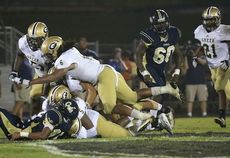
Julie McCombs
Helmet-to-helmet collisions are not the only cause of concussions. A head hitting the ground can cause a whiplash-like effect that may trigger a concussion.

Julie McCombs
Greer Head Coach Will Young is trying to save his players for Friday night games by limiting contact during practices.
Bill Utsey was taught to use his head as a battering ram when he played football. Now he’s charged with enforcing South Carolina law against that mindset.
“I know one thing, when we were playing you were taught to lead with your head because the helmet was like a battering ram,” Utsey said. “One of the things we were told: ‘We may lose to an opponent but we would outhit them.’ That was the kind of mindset we had.” Utsey is Director of Athletics of Greenville County schools.
As concussions have become the paramount concern in football and other contact sports, so has the issue of the value of conducting full-speed, full-contact drills during the week.
Will Young, Greer High School Head Football Coach, an All-ACC offensive lineman with the Clemson Tigers, is a physically minded coach. That was the way he played and how his practices, at times, were conducted.
Now Young and Utsey agree practices are not the place to lose players to injury.
Young, in fact, told his players practices would be less about contact. One week after that statement, Young hasn’t backed off. He’s just trying to figure out how to conduct game-like drills without his players paying the price with injuries that cost playing time.
“It’s a big challenge. You don’t want to go out and beat everybody up. We need the kids we have to be healthy,” Young said. “But we want the kids to play fast, but not try to take each other down.”
“Some coaches may subconsciously be pulling back although none have told me they are,” Utsey said. What Utsey is referring is the state law Gov. Nikki Haley symbolically signed at Dorman this summer requiring parents and players read about concussions and the protocol to return to practice. Athletes and parents must sign the documents.
The law also puts some responsibility on the players: “If I suspect a teammate has a concussion I am responsible for reporting the injury to my athletic trainer,” reads one bullet point.
“Today, you can’t teach tackling with your head any more. You are teaching shoulder tackling, shoulder and hand blocking,” Utsey said. “Helmet to helmet contact was the norm. And now it’s totally opposite.”
Zeke Whiteside, a defensive back/wide receiver for Greer suffered a concussion in a scrimmage and only last week was given a doctor’s release to begin the protocol to return to practice.
Malek Johnson, a senior defensive back, has a shoulder injury that still keeps him from practicing. He is looking to get approval to begin practice this week, but that doesn’t necessarily mean he will play Friday against Riverside.
Those two injuries are reasons enough for Young to tell his players less hitting and more “shadow tackling” will be the norm during weekly practices now that the season has started.
“They’re not going to be taking down their teammates during drills. Monday through Thursday we can’t afford to lose anybody. Sometimes we may shadow tackle or run by players. We want to save our players for the game,” Young said.
It’s a combination how fast the athletes have become and the violent collisions that routinely occur. Greer, as evident with most schools below Division 4A, is not deep with players.
Dorian Lindsey, the Greer starting sophomore quarterback throughout the summer, had to be moved to defensive back when Johnson suffered his injury. “Dorian gives us more depth back there,” Young said. Lindsey played the entire game on defense against Seneca.
“When I played (The Citadel), as a walk-on, the one thing I hated, was for a player to practice form tackling. I was a body. They would tackle us and when I fell backward my head would hit the ground, like a whiplash effect. There’s no telling if I had concussions,” Utsey said.
Officials remain ambivalent enforcing the South Carolina High School League’s mandate of removing a player for one play when a helmet comes off during a scrimmage.
A Gaffney player lost his helmet during a scrimmage at Greer this summer and continued to play, despite coaches from both teams and two sets of officials on the field. When two officials were asked the protocol for scrimmages, they said they didn’t know.
“To me, I would have had the player sit out a play,” Utsey said.
“We’ve got to be a little smarter as coaches,” Young said referring to the how much contact players have during the week and teaching fundamentals that reduce potential of injuries.
State law dictates when athletes may return to practice. “A player gets a concussion and you figure it will be at least two weeks before they return to the field,” Young said. Diagnosis, recovery and then a doctor’s release are normally one week. Whiteside also followed the protocol where he had to pass physical activity monitored by the team’s trainer and take tests to compare his baseline score versus the present.
“I know if I was a coach, I could subconsciously be cutting back,” Utsey said. “I would be conscious of how I teach, what I teach and how often I practice (contact).”